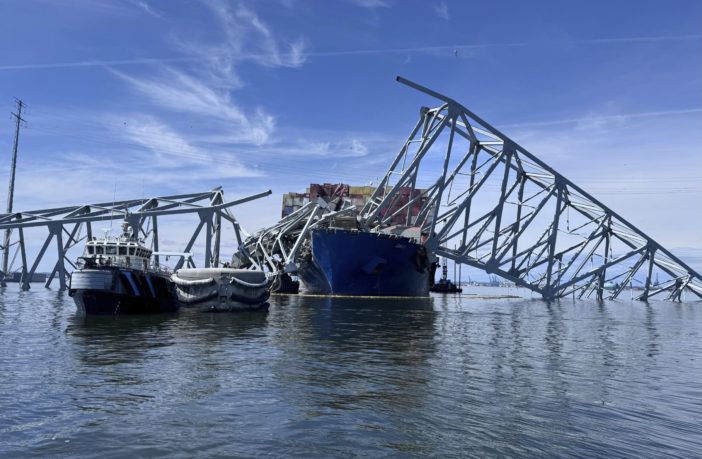By Megan Sayles,
AFRO Business Writer,
msayles@afro.com
As authorities race to clear the wreckage of the Francis Scott Key Bridge from the Patapsco River, dock workers at the Port of Baltimore are experiencing mounting uncertainty about the future of their jobs.
International Longshoremen’s Association (ILA) Local 333, which represents 2,400 maritime workers at the port, already has more than 1,800 members out of work, according to President Scott Cowan.
“It’s a scary time for us. I mean this is how our members feed their families, send their kids to private school and put gas in their cars,” said Cowan. “Without the docks they have problems doing that.”
Two temporary channels have been opened to allow limited vessel traffic, but Cowan said the passageways will not provide immediate relief to the dock workers. A third channel will be open by the end of April and by May the Army Corps of Engineers expects the channel currently blocked to be fully reopened.
ILA is stepping in to cover workers’ retirement and healthcare benefits, but government assistance is required for lost wages.
“We need supplemental wages. We will take care of the rest internally. We’re not looking for somebody to cover everything for us, we can take care of ourselves,” said Cowan. “But, at a time like this where you never prepare for something like this happening, we do need help with some supplemental wages.”
Cowan said workers can withstand a few weeks of the port being closed before it causes permanent damage to their livelihoods.
“We need to get the shipping channel open so we can get back to work and get this economy rolling again for the state,” said Cowan. “It’s not just about the ILA members. It’s about the truckers, the warehouse, the consumers and the economic driver in the port. We’re losing $191 million a day in economic impact by this channel not being open.”
On April 4, Maryland Gov. Wes Moore signed an executive order that “directs $60 million to provide immediate temporary economic relief to support businesses and workers impacted by the Francis Scott Key Bridge collapse,” according to information released by his office on effort.
The Small Business Administration has also set up two centers to help those impacted apply for loans and grants to help them as they recover from the financial impact of the bridge collapse.
The Port of Baltimore contributes nearly $3.3 billion in total personal income to the local economy. It generates more than $395 million in taxes and $2.6 billion in business income. More than 15,000 direct jobs and over 139,000 related jobs are supported by the port.
Aside from ranking number one for automobiles, the Port of Baltimore also leads in farming and construction machinery and is the second in the country for coal exports.
As shipments are diverted to other ports on the East coast, Louis Campion, president of the Maryland Motor Truck Association, said trucking companies are struggling to serve their customers.
“We have a scenario where global trade routes are being modified and supply chain shifts are occurring as diversion happens with cargo ships going to places like Norfolk, New York, New Jersey or Philadelphia,” said Campion. “That’s when we really start to take it on the chin because our members are scrambling to figure out how they can provide services to customers as that freight is diverted.”
Before the collapse, about 4,800 trucks crossed the Key Bridge daily, according to Campion. Now, truckers have lost a critical transportation link. Those carrying hazardous materials also do not have the option to use the Fort McHenry or Baltimore Harbor Tunnel.
“With regards to hazmat, depending on what you’re delivering and where you’re delivering to, it could be an extra 30 miles around the West side of the 695 beltway,” said Campion.
“Cargo needs to come back to Baltimore as quickly as possible,” he added.
Experts do not think the disturbance to the Port of Baltimore will have long-term effects on the U.S. supply chain, particularly because most cargo can be diverted to other ports.
“Baltimore is a mid-sized port. It’s big, but relative to Los Angeles and Long Beach or New York and New Jersey it’s not that large,” said Philip Evers, associate professor of supply chain management at the University of Maryland. “While it does handle quite a few containers through the port, every container ship that goes to Baltimore passes the port in Norfolk and Philadelphia. It’s a short-term effect as long as there’s enough capacity.”
However, Evers said re-routing coal shipments may be challenging.
“There are two big coal piers in Baltimore. It’s a lot harder to divert because there are far fewer coal piers on the East coast,” said Evers. “They will be jammed up for a while.”
As cargo is redirected, some worry that the detours will become permanent. Omar Khan, professor of international business and marketing at Morgan State University, said the concern is legitimate but not likely.
“These industries and industry subsectors have been utilizing the Port of Baltimore for decades. The guidance that they gave to their loaders, unloaders and mechanics and the efficiencies that were required from the truckers were created and practiced over decades,” said Khan.“I expect that once the port reopens and is fully serviceable as it was prior to the bridge collapse, most, if not all, of the industry activity will return very quickly.”
Megan Sayles is a Report for America corps member.



